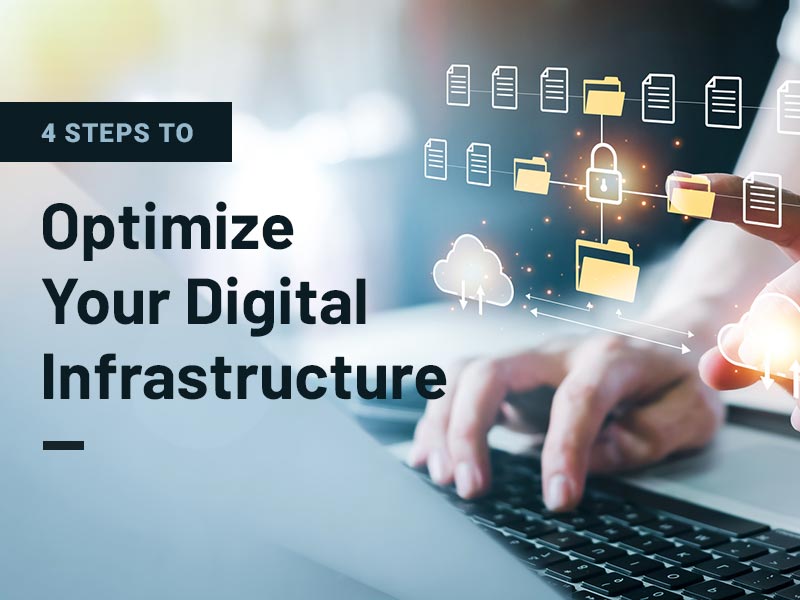In today’s digital age, maintaining and optimizing a robust digital infrastructure is not just an option, it’s an absolute necessity. A solid digital infrastructure supports communication, data storage, application hosting, and more. But how does one ensure that this vital structure is performing at its peak? This guide provides a step-by-step approach to enhancing the performance of your digital infrastructure.
1. Understanding The Landscape: Examining Your Current Infrastructure
The first step toward optimizing any system is to understand its current state. The same principle applies to digital infrastructure. Here are the steps you need to take:
- Identify the components of your existing digital infrastructure, including networking equipment, servers, storage devices, and software applications.
- Evaluate how they interact and integrate to support your operations.
Seeking assistance from a managed IT support provider at this stage could be beneficial. These professionals can thoroughly audit your digital infrastructure, ensuring that no component remains overlooked.
2. Defining The Future: Assessing Your Needs And Setting Goals
Once you have a comprehensive picture of your current digital infrastructure, the next step involves determining your specific needs. Here are the tasks you need to do:
- Identify potential issues in your existing digital infrastructure, such as slow systems, insufficient storage space, or inadequate security measures. You will also need to make sure you have a strong failsafe for any power issues. Luckily most countries have a strong telecom infrastructure however, if something were to happen you would need backup power to keep your digital infrastructure up and running. To deal with this issue you should have a Telecom-Battery. These are larger capacity units with high durability, long cycle life, and the ability to discharge at a high rate, which makes them a high-quality backup for commercial businesses.
- Consider future business growth and new initiatives. It’s time to look ahead. What does the future of your business look like? How will growth or new initiatives impact your digital infrastructure needs? Consider factors such as increased data volume, additional users, or changing technology requirements.
- Define clear and measurable objectives that align with your assessment, such as improving system speed and performance, enhancing data security, ensuring seamless scalability, or optimizing resource utilization.
By performing a thorough assessment of your needs and setting well-defined goals, you can align your optimization efforts with your business objectives and ensure that your digital infrastructure is poised to meet the demands of the future.
3. Crafting A Blueprint: Developing An Optimization Plan
Once you have a firm understanding of your current digital infrastructure and have set clear goals, it’s time to create a blueprint—a comprehensive optimization plan that outlines the specific steps and actions required to achieve your objectives. The steps below outline how to create an effective optimization plan:
- Evaluate your current digital infrastructure. Revisit your assessment of the existing structure, and identify areas that require improvement based on the goals you have set.
- Research and explore solutions. Conduct research to identify potential solutions or technologies that can address the issues identified in your assessment.
- Develop a comprehensive roadmap for implementation. Develop a step-by-step plan outlining the specific actions required to optimize your digital infrastructure. Break down the tasks into manageable stages, considering dependencies, resource allocation, and timelines.
- Allocate resources and budget appropriately. Determine the resources, both human and financial, required for the successful implementation of your optimization plan. Assess your budget and allocate funds accordingly.
- Communicate the plan. Share the optimization plan with all relevant stakeholders, including IT teams, department heads, and management. Effectively communicate the objectives, strategies, timelines, and expected outcomes to all relevant stakeholders. Encourage collaboration, and address any concerns or questions raised by stakeholders.
- Implement and monitor. Put your plan into action, following the defined roadmap. Monitor the progress closely. Track key performance indicators (KPIs). Evaluate the impact of each implemented change.
By crafting a detailed optimization plan, you provide a structured approach to improving your digital infrastructure.
4. Action And Evolution: Implementing Changes And Continual Improvement
After creating a detailed plan, it’s time for the implementation and monitoring phase. This is something that could be made easier with a cloud consultancy firm that specializes in data security, compliance, and reconfiguring cloud infrastructure to suit a business’s need. They can assess your plan and implement it swiftly, whilst providing support for the following steps.
- Undertake these changes in a phased manner. This approach allows for continuous monitoring of the impact each alteration has on overall system performance, making it convenient to identify and rectify potential issues swiftly.
- Remember, optimization is not a one-and-done event. It’s a process of continuous improvement. This final step—monitoring and tweaking—is perhaps the most critical of all.
- Making these changes is just the starting point. Once the changes are implemented, closely monitor the performance of your digital infrastructure.
Utilize real-time data and performance metrics to gain insights into how your systems operate. If needed, be proactive in fine-tuning and adjusting to ensure optimal performance.
Reaping The Rewards: The Benefits Of Optimization
By following these steps, you will experience a significant improvement in the efficiency, security, and reliability of your digital infrastructure. The benefits extend beyond the technical realm. An optimized one enables your business to promptly respond to market changes, streamline internal operations, and deliver enhanced services to customers.
It is essential to recognize the importance of expert assistance throughout this process. Collaborating with a managed IT support provider can guide you through this optimization journey, offering extensive experience, knowledge, and specialized tools to support the task. That being said, it is important to remember that managed service providers are only human too, so leaning on them too much can lead to degeneration in the quality of your digital services. A key takeaway to remember is having difficult clients is the leading cause of IT technician burnout, so from a business and client management perspective you temper both internal and external expectations.
Final Thoughts
The optimization of digital infrastructure is a continuous and dynamic process that demands a clear understanding of your current situation, a vision for future needs, a meticulously crafted optimization plan, and a dedicated commitment to continuous monitoring and improvement. Despite the complexity of the journey, the results—highly efficient, secure, and scalable digital infrastructure—justify the effort.







